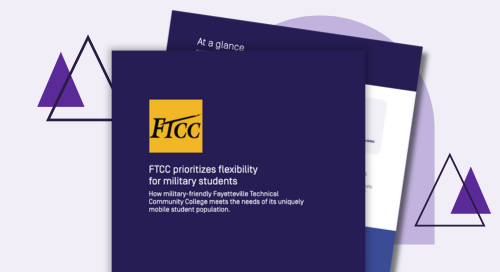


“With Watermark Student Success & Engagement, now my secretary can log in and, when a student calls, she can pull up data very quickly and say, ‘Oh, you’re taking this class,’ or, ‘Looks like you had this come up last semester.’ It is so nice to finally have one place to house all of this information, I can’t tell you. It’s like night and day. We love it.”
Cameron Harmon, Ed.D. Dean of Math and Sciences, Head of Transfer Advising Center, and System Admin. for Student Success & Engagement, Fayetteville Technical Community College
Among the largest institutions that make up the North Carolina Community College System is Fayetteville Technical Community College (FTCC) in Fayetteville, North Carolina. The school, voted one of the top 10 military-friendly colleges in the United States for the past five years, has a culture heavily shaped by this population.
FTCC is situated near Fort Liberty, the largest U.S. military base in the world, and serves many of the area’s veterans, active-duty personnel, and military family members. (The base officially changed its name from Fort Bragg in June 2023 as part of a Department of Defense initiative, spurred by the 2020 George Floyd protests, to rename installations honoring Confederate soldiers.)
The school has also been recognized by the National Initiative for Cybersecurity Careers and Studies as one of the National Centers of Academic Excellence in Cyber Defense programs across the country. Alongside its accomplishments, however, FTCC has faced challenges associated with its uniquely mobile student body.

When Dr. Harmon joined the school in 2009, one of her first assignments was to facilitate an online biology class. Then, “we had just started to dip our toes into the water” when it came to online programming. By 2020, when the COVID crisis hit, the college was well-prepared.
Still, as FTCC saw declining enrollment numbers, they knew that they needed to bolster their efforts toward
retention. “Part of our strategic plan is making sure that we have advising centers across the campus so we can ensure that, as our students are being onboarded, they are each having that tailored experience, making them feel included, and that they have that team of people here to support them,” says Dr. Harmon. “It makes it easier for them to know who to reach out to, how to reach out, and also, from our standpoint, it makes it easy for the faculty to see what’s going on with that student.”
Before this point, FTCC did not have any mandatory advising in place and, because faculty were gone during the summers, there was no consistent point of contact for students starting school between academic years. This made it difficult to track and address many issues that affected retention.
For example, FTCC had a large number of students who were sidelined as ineligible for course enrollment because they lacked prerequisites or were misaligned with their program’s goals. These students would frequently go without knowing of this ineligible status until well into the enrollment period.
The school needed a single source of truth that could offer sophisticated, robust tracking of student learning milestones, and predictive analytics that facilitated early intervention strategies.
This was especially crucial for their minority male students, whose retention was often in greater jeopardy. The right system would make it harder for students to fall through the cracks, even if they were switching between advisors or on a nontraditional academic path.
Unfortunately, FTCC had previously chosen a software vendor that under-delivered on its promise to provide this ease of communication. “It did not get our data right,” recalls Dr. Harmon. “It was a mess. Their customer service was slow and provided unhelpful solutions. I was like, ‘Why are we doing this?’” With these inefficiencies fresh in mind, Dr. Harmon pushed hard for a more suitable system.
In 2022, after consulting with another North Carolina community college that had found success with the Watermark Educational Impact Suite, FTCC piloted Watermark Student Success & Engagement (SS&E).
“I have to give a shout-out to Gaston College,” says Dr. Harmon. “Talking to Gaston was amazing. They had seen such a good outcome from using it. And then I was like, ‘Wait a minute, there are how many other community colleges using Watermark?’”
After talking with Gaston College about the benefits of working with a software provider who had deep roots with community colleges, she realized that there was no need to “reinvent the wheel,” says Dr. Harmon. “That’s kind of what we were trying to do with this other vendor.”
“With Student Success & Engagement, now my secretary can log in and, when a student calls, she can pull up data very quickly and say, ‘Oh, you’re taking this class,’ or, ‘Looks like you had this come up last semester,’” says Dr. Harmon. “It is so nice to finally have one place to house all of this information, I can’t tell you. It’s like night and day. We love it.”
In January 2023, as part of its quality enhancement plan, FTCC introduced success coaches into its advising model through a pilot program. Enabled by SS&E and demonstrated to improve student learning outcomes, custom advising can make all the difference in engagement.
“Everyone loved it,” says Dr. Harmon. “We had the best responses from students. Before, we would email students all the time and send them important information hoping they would read it. And then, all of a sudden, we started using this and students were responding.” Through the new system, success coaches have been able to create cohorts and tags for tracking the students within those cohorts, streamlining communications immensely. “Before, they were doing everything in Excel. Now, they can just pull everything from SS&E. That is making life much, much easier.”
Before, they were doing everything in Excel. Now, they can just pull everything from Student Success & Engagement. That is making life much, much easier.
FTCC has also appreciated the ease of information sharing between SS&E and the other Watermark products in the Educational Impact Suite, including Faculty Success, Student Learning & Licensure, and Planning & Self-Study. Although the school had some of these products in place earlier than others as part of their assessment process, they only recently began to use them in tandem to maximize outcomes. “One of the factors we’re looking at now is how impactful some of our practices are in terms of student retention, right?” says Dr. Harmon. “With all these awesome reporting features in SS&E, we’ve been able to pull data and demonstrate how we’re achieving those goals in Planning & Self-Study. So it’s all tying together.”
The transition to Watermark solutions was not immediately met with enthusiasm. Dr. Harmon was wary after the experience with the previous vendor, but a great team supporting the transition kept her moving forward, including the support from Watermark staff.
Ultimately, her team was able to secure buy-in from academic advisors, success coaches, and IT. Helped by her own standing as both faculty and administrator, the team also eventually won over faculty and staff. “I think messaging is a big part of it,” says Dr. Harmon.
“You want faculty to understand what you’re doing this for — that it’s going to make their life easier. And so we started from that standpoint: This is going to help you. But, more importantly, it’s for our students.
This is what’s going to help them be successful in their journey, feel included, and know that someone’s taking care of them.”
Together, Dr. Harmon and her support team looked at their strategy from all angles and came up with ways to promptly address any issues with the new system, including a website with tutorials and a dedicated email for troubleshooting. “We have tried to make it a point to triage anything within the hour, to get it taken care of so that people feel like they’re being heard,” she says.

Some of the faculty are still pinching themselves. They were struck by the “cool” dashboard at first, says Dr. Harmon, but with time their appreciation has grown deeper: “The automated alerts. Oh my gosh. Faculty love the automated alerts. They’re like, ‘You mean, I don’t have to do this every time?’ It has been so wonderful.” These automated alerts let the success team know when a student is exhibiting behaviors that could negatively impact their academic performance. Rather than having to manually search for such warning signs — and often only after it’s too late for meaningful intervention — schools can choose which automatic alerts to enable and customize them as needed.
“The automated alerts. Oh my gosh.
Faculty love the automated alerts. They’re like, ‘You mean,
I don’t have to do this every time?’ It has been so wonderful.”
They’ve also seen success using Watermark to alert them of students who had completed fall semesters but not yet signed up for spring classes. “We pulled that data to reach back out to them to see if they were coming in for the second eight weeks or even summer,” says Dr. Harmon. “We had quite a few people who, once we sent messages out, followed up and made appointments.”
Its breadth of outreach to current students is one of the features that sets Watermark apart from competitors, and, as Dr. Harmon came to find after setting up automated messages to be sent out to students on their birthdays, it drives progress in unexpected ways.
“I did not know that would make a huge difference,” admits FTCC advisor Ebony Cannon. “I just was like, ‘Oh, I’m gonna create the template and do the birthday message.’ There was one girl, she came to me and said, ‘You don’t even know how much your message meant. I’ve just been going through so much.’”
The young mother had been struggling to decide whether college was the right place for her, and this note on an important day made her feel cared for. Maybe she took it as a sign. “She’s here,” says Dr. Harmon. “She’s taking more classes. I know that’s not a hard data point. But I think with everything that our students have experienced — that they’re continuing to experience — getting through COVID, all this political upheaval … I think we miss those things sometimes, how valuable that experience really is.”
Dr. Harmon and her team continue to be impressed by the differences they’ve seen at their institution. In the future, Dr. Harmon hopes to see even more Watermark solutions put into motion at FTCC. But, for now, they’re getting used to a new way of doing things. “Change is slow. Change is slow. We’ve got some folks in certain areas that have been there for a very long time, and it’s not how they’ve always done things.” Still, they are making progress step by step. “We are getting there.”

See how our tools are helping clients right now, get in-depth information on topics that matter, and stay up-to-date on trends in higher ed.